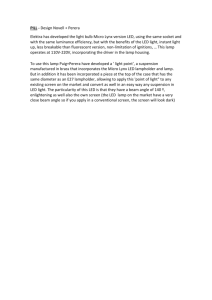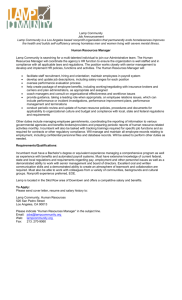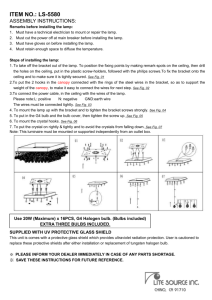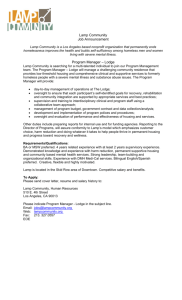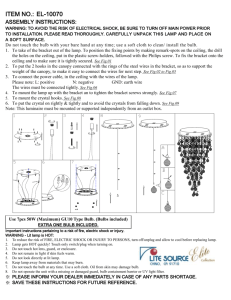"TMD-EF" N i k o n EPI-FLUORESCENCE ATTACHMENT
advertisement
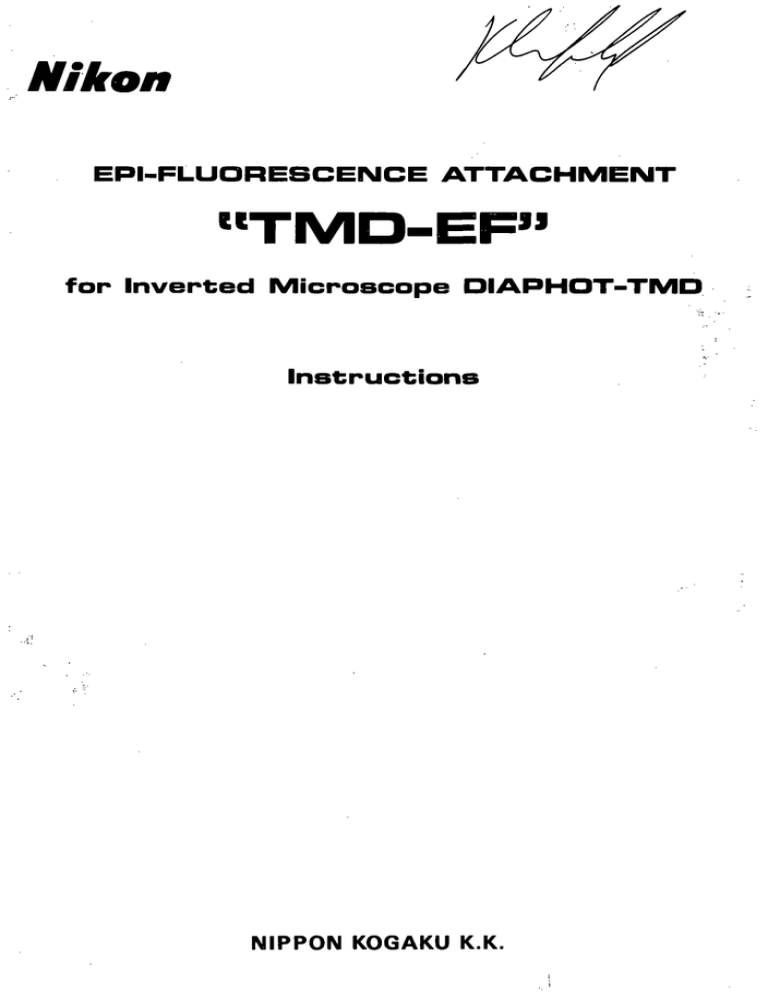
Nikon EPI-FLUORESCENCE ATTACHMENT "TMD-EF" for Inverted Microscope DIAPHOT-TMD Instructions NIPPON KOGAKU K.K. The Epi-Fluorescence Attachment "TMD-EF", mounted on the Nikon Inverted Microscope DIAPHOT-TMD, permits epi-fluorescence microscopy, using the high pressure mercury lamp. The user is recommended to read, in addition to the instructions as below, the Instruction Manual for the Nikon Inverted Microscope DIAPHOT-TMD. CAUTIONS o Avoid sharp knocks Handle the attachment gently, taking care to avoid sharp knocks. Locations of microscope Use the attachment in a dark or semidark room free from vibration and store it in a place protected from direct sun shine, high temperature, humidity and dust. Dirt on the lens Do not leave dust, dirt or finger marks on the lens surfaces. They will prevent you from clear observation of the specimen image. o e Power source voltage and frequency indicator To use the high pressure mercury lamp, make sure of the correct setting of the power source voltage change-over switch and frequency indicator card on the rear side of the mercury lamp starter. Be sure to use the earth connection from the starter and to put the correct fuses into the fuse holders. High pressure mercury lamp (HBO-100W/2OSRAM) • Important! Observe the following precautions before operating the high pressure mercury lamp illuminator. The life of the high pressure mercury lamp will be about 200 hours. Exchange it to a new one after about 200 hours' lighting. The lighting time of the lamp can be confirmed by the time integrator (elapsed time meter) on the starter. Before replacing the mercury lamp or fuse, be sure to turn OFF the power switch and disconnect the p^ug from the power source. In exchanging the lamp bulb, do not touch the glass part of the lamp bulb with bare hands. Dust, dirt or finger marks on the bulb surface should be wiped with alcohol. For attaching the mercury lamp bulb to the socket, take note of the polarity of the bulb. Before lighting the lamp, confirm that the lamp bulb is properly fitted in the lamp housing. Do not look directly_or indirectly at the light coming from the mercury lamp. (Never turn ON the lamp outside of the lamp housing or with the lamp housing removed from the microscope stand.) Take care not to touch the lamp housing, and do not bring inflammable substances such as gasoline, thinner or alcohol near to the lamp housing, as some parts of the lamp housing may take a high temperature. Mercury lamp may not relight immediately after turned OFF, according to its speciality. Wait until more than 5 minutes have elapsed. CARE AND iVIAINTENANCE Cleaning the lenses To clean the lens surfaces, remove dust using a soft brush or gauze. Only for removing finger marks or grease, should soft cotton cloth, lens tissue or gauze lightly moistened with atjsolute alcohol (methanol or ethanol) be used. C O N T E N T S I. NOMENCLATURE Q II. ASSEMBLY Q For cleaning the objectives use only xylene. Observe sufficient caution in handling alcohol and xylene. e > 29 Cleaning the painted surfaces Avoid the use of any organic solvent (for example, thinner, ether, alcohol, xylene etc.) for cleaning the painted surfaces and plastic parts of the instrument. A 3. Attaching the lamp housing 4. Connection of the starter A A 5. Attaching the light shield t u t * 6. Attaching the light shield plate 7. Attaching the objectives and lamp centering tool A A 8. Attaching the filter cassette A I I I . PREPARATION A A Q 1. Attaching the filter cassette A Never attempt t o dismantle the instrument so as t o avoid the possibility of impairing the operational efficiency and accuracy. 2. Lighting the lamp 3. Adjustments of interpupillary distance and diopter 4 . Centering of the lamp A A A When not in use 5. Centering the field diaphragm A Never attempt t o dismantlel When not in use, cover the instrument w i t h the accessory vinyl cover, and store it in a place free from moisture and fungus. It is especially recommended that the objectives, eyepieces and filter cassettes be kept in an airtight container containing desiccant. e . .. 1. Attaching the epi-fluorescence attachment main body 2. Attaching the lamp bulb and socket IV. MICROSCOPY 1. Procedure in sequence 2. Manipulation of each element 1) Use of filters 2) Use of field diaphragm 3) Use of shutter 4) Use of ND filter Periodical checking To maintain the performance of the instrument, we recommend t o check the instruments periodically. (For details of this check, contact our agency.) V. ^ ^ A A A A ^ FLUORESCENCE PHOTOMICROGRAPHY V I . T R O U B L E SHOOTING T A B L E ^ ^ I. NOiVIENCLATURE Light shield plate Epi-fluorescence attachment "TMD-EF" main body High pressure mercury lamp housing CF Objectives and centering tool Fig. 1 o I. NOMENCLATURE Lamp housing Rear mirror centering screw ND f i l t e r - Field diaphragm centering screws I — Socket sleeve Socket sleeve clamp screw I — Lamp vertical centering ring Field diaphragm lever Shutter Lamp lateral centering screw Collector lens p a r t - Socket sleeve receptacle — Clamp screw (-^ pole) High pressure mercury lamp (HBO 100W/2) Clamp screw Epi-fluorescence attachment main body Lamp housing f—Excitation method change-over knob Indication window Filter cassettes /UV, V, BV, B, B 2 a n d i \G excitation methods' Light shield tube Cassette holder Light shield plate Centering tool Time integrator w i t h compensation ring CF40> CF20.< CF 10< Pilot lamp Reset button , m .^'^ .... 01 ' • "1 •• J (DF Objectives V --* Lamp input connector (Low voltage side) Lamp input connector (High voltage side) Power switch Starter button Starter Fig. 2 II. 1. Attaching the epi-fluorescence attachment main body (Fig. 3) To insert the attachment main body into the attaching sleeve on the microscope stand, fitting the notch on the sleeve to the pin on the main txjdy, thrust it until it stops. Fasten the main body in this position by means of the clamp screw. When using the incubator, attach the epi-fluorescence attachment, before mounting the incubator plastic case. Lamp housing Lamp housing clamp screw Rear mirror centering screws Socket sleeve Clamp screws Socket sleeve clamp screw High pressure — > ^ j mercury lamp Nk Plus (+) pole''''^ DIAPHOTTMD main body Epi-fluorescence — attachment main body Fig. 4 /- Attachment m a i n - __ / b o d y clamp screw Fig. 3 2. Attaching the lamp bulb and socket (Fig. 4) Release the socket sleeve clamp screw, and pull out the socket sleeve from the lamp housing. Attach the lamp txilb with its plus (+) marked pole connected to that of the socket, and clamp it with the bulb clamp screws on the socket. Caution: Do not touch the glass part of the lamp bulb with bare hands. Use gloves, cloth or the like to avoid leaving finger marks. Turn the rear mirror centering screws on the lamp housing back clockwise to release the clamping of the rear mirror. Insert the socket sleeve into the lamp housing, and fasten it with the socket sleeve clamp screw. 3. Attaching the lamp housing (Fig. 4) Attach the lamp housing onto the collector lens part of the epi-fluorescence attachment main body, and fasten it firmly by means of the lamp housing clamp screw. 4. Connection of the starter (Fig. 5 & 6) Connect the high voltage cord (black) and the low voltage cord (grey) to the receptacles "OUTPUT H" and "OUTPUT L" on the starter, respectively. (Fig. 5) Releasing the grounding terminal on the rear side of the starter, connect the grounding cord. Remove the fuse holders and attach two fuses both of 3A/125V or 2A/250V. Connect the power source cord to the power source input receptacle. (Fig. 6) Lamp input connectors High voltage-i side Front side of the starter Low voltage side Fig. 5 Rear side of the starter- Fuse (2 pieces)- Earth Power source cord Fig. 6 II. A S S E M B L Y 5. Attaching the light shield tube (Fig. 7) Attach the light shield tube to the condenser mount on the microscope stand, as shown in Fig. 7. Condenser clamp screw Condenser m o u n t - 8. Attaching the filter cassette Choose the filter cassette corresponding to the excitation method to te used, and remove the screw on the filter cassette. (Fig. lO-Uj) Insert the filter cassette into the dovetail groove of the cassette holder, fasten the clamp screw. Depress and turn the milled part of the excitation method change-over knob so as to set the indication of the attached filter cassette. (Fig. 1G-ilj) Filter cassette ! } •- Light shield tube \\ -Screw / Fig. 7 6. Attaching the light shield plate (Fig. 8) Attach the light shield plate onto the bottom of the binocular eyepiece tube as shown in Fig. 8. Filter cassette clamp screw . -Cassette holder Excitation method change-over knob Light shield plate — Indication window Fig. 10 Fig. 8 7. Attaching the objectives and lamp centering tool (Fig. 9) Beforehand, rotate the coarse focus knob to move the revolving nosepiece to the lowest position. Attach the objectives to the nosepiece from the left side one after another in such positions that the magnifying power increases, as the nosepiece is revolved clockwise. Screw in the centering tool into one of nosepiece revolver hole with no objective. Remove the righthand cover of the mount of the revolving nosepiece by unscrewing the two attaching screw. Insert the cassette holder into the mount as shown in Fig. 11. Caution: Push it in until it click-stops positively. Click groove Fig. 11 For assembling the main body of the Inverted Microscope DIAPHOT-TMD and other units, refer to the Instruction Manual for the Microscope DIAPHOT-TMD. Fig. 9 o III. PREPARATION 1. Attaching the filter cassette Insert the cassette holder with the filter cassette to be used into the mount of the revolving nosepiece until it click-stops positively. (Refer to p. 7-8.) 2. Lighting the lamp 3. Adjustments of interpupillary distance and diopter 1) Place the specimen on the stage. 2) Turn the field diaphragm lever up to [0] to open the diaphragm fully. (Fig. 13) (Fig. 12) Field diaphragm centering screwi Reset button / To the lamp housing -Power switch "' ' - Starter b u t t o n -U = ield diaphragm lever Fig. 13 Fig. 12 1) Depress the reset button on the starter of the mercury lamp, and set the time integrator to 0 (also when the lamp has t)een replaced). 2) Insert the plug of the power source cord connected to the starter into the power source socket, and turn ON the power switch. After making sure of the pilot lamp lighted, depress the starter button for 2 ~ 3 seconds to light the lamp. 3) The arc will become stable 15 minutes after lighting. Observation, however, can be started after 2 ~ 3 minutes. Note that a duration of lighting not longer than 15 minutes is liable to shorten the life of the lamp. 4) For relighting, depress the starter button after waiting a time longer than 5 seconds, when the mercury lamp cools down. 3) Pull the shutter knob to remove the shutter out of the optical path. (Fig. 14) Fig. 14 4) Bring the specimen image into focus, using the lOx objective. 5) For adjusting the interpupillary distance and diopter ring, refer to the Instruction Manual for the Nikon Inverted Microscope DIAPHOTTMD. (p. 10 and p. 11, respectively) 4. Centering of the lamp 1) Bring the specimen image into focus, using the lOx objective. 2) Swing in the centering tool into the optical path, turning the window of the tool aside. (Fig. 15) III. Centering window Centering tool PREPARATION Rear mirror centering screws -Rear mirror lead screw Socket sleeve clamp screw ^Lamp vertical centering ring Lamp lateral centering screw Fig. 15 Fig. 17 3) Release slightly the clamp screw on the lamp housing. Moving the housing back and forth, bring the arc image into focus on the window of the centering tool. In this position of the lamp housing, fasten up the clamp screw. (Fig. 16) m Fig. 18 Lamp houing clamp screw Fig. 16 4) Release the clamp screw on the lamp socket sleeve. Manipulating the lateral centering screw and vertical centering ring (Refer to Fig. 17), bring the arc image to the center of the cross line in the centering tool. (Fig. 18-[ll) 5) Move slightly the vertical centering ring to decenter the arc image. Move the rear mirror back and forth by rotating its lead screw to bring the reflected (mirror) image of the arc into focus on the window of the centering tool. 6) By means of the rear mirror centering screws, bring the arc image to a symmetrical position to the reflected (mirror) image. (Fig. 18- L?]) 7) By means of the vertical centering ring, bring the arc image to the center of the window of the centering tool, so that the arc image and the reflected image overlap each other. 5. Centering the field diaphragm 1) Using the lOx objective, bring the specimen image into focus. 2) Stop down the field diaphragm to a small opening. 3) If the field diaphragm is found decentered in reference to the viewfield of the eyepiece, make adjustment by means of the field diaphragm centering screws (Refer to Fig. 13), until a concentric position is obtained. 4) Open the field diaphragm up to the same area as the eyepiece viewfield. If it is found decentered, use the field diaphragm centering screws for exact centering. (Fig. 19) Viewfield diaphragm image •^ Eyepiece viewfield Fig. 19 IV. MICROSCOPY "1 , Procedure in sequence m Choose the filter cassette in accordance with the excitation method being adopted, attach it to the microscope. (Refer to p. 7 - 8.) Place the specimen on the stage. Light the lamp. (Refer to p. 8 • 2.) • Make adjustments of interpupillary distance and diopter. (Refer to p. 8-3.) Perform centering of the lamp. (Refer to p. 8 - 4.) l i M Carry out centering of the field diaphragm. (Refer to p. 9 - 5.) Swing in the objective to be used, and do focusing. « • Adjust the brightness of image, using ND filter. (Refer to p. 14-4.) E M Adjust the field diaphragm. (Refer to p. 13 - 2.) Note: • • It is necessary to use glass slides and coverglasses of nonflu o rescen ce_ty pe. Self-fluorescence, if involved in culture bottles, etc. may cause some difficulty in observation of fluorescent specimens. Use culture bottles free from self-fluorescence, if possible. IV. M I C R O S C O P Y 2. Manipulation of each element 1) Use of filters Select the filter cassette according to the excitation method which is suitable to the specimen, in reference to the Table 1 and the spectral transmissions of filters. (Fig. 20~Fig. 25) Table 1 Excitation Method and Filter Combination Filter cassette Excitation method Main wave length Type of staining UV (Ultraviolet) 365nm A u t o fluorescence, Hechist, Immunofluorescence (FITC) 405nm Monoamines (Catecholamines, 5HT) BV (Blue violet) 436nm B, B2 (Blue) G (Green) V (Violet) • Eyepiece-side absorption filter Code Excitation filter Dichroic mirror UV UV330~380 DM400 420 V 1 F395~425 DM455 470K Quinacrinemustard BV 1 F400~450 DM455 480 495nm Immunofluorescence (FITC), Auramine B B2 IF420~485 1F460~485 DM510 520W 546 nm Immunofluorescence (TRITC, RB200). Feulgen reaction G IF535~550 DM580 580W UV (Ultra violet) excitation method = — i = = lOOr— DM400-, -4?0 'E ;-UV330 50- \ L- ~^^° m CD n t/3 I' \/ i V -^ \ J n,^-- '• \ i / 3 10 4C 0 500 Wavelength (nm) 600 700 Fig. 20 IV. M I C R O S C O P Y V (Violet) excitation method) 400 500 600 700 Fig. 21 Wavelength (nm) BV (Blue violet) excitation method r-DM455 IF400 ^ J- z: "s:-^ 450 R ) 400 ' X "•x— 480 J / 500 Wavelength (nm) B (Blue) excitation method 500 Wavelength (nm) 700 Fig. 22 IV. M I C R O S C O P Y B2 (Blue) excitation method 300 400 450 500 550 600 650 700 Fig. 24 Wavelength (nm) G (Green) excitation method 400 600 500 Wavelength (nm) • For the use of filter cassette B/G For using the filter cassette B/G, aperture ring must be inserted into the mount of the revolving nosepiece. (Fig. 26) 70G Fig. 25 2) Use of field diaphragm The field diaphragm is used for determining the illuminated area on the specimen surface in relation to the field of view of the microscope by turning the field diaphragm lever. Generally, it is stopped down to such an extent that the circumference of the illuminated area circumscribes_or inscribes that of the eyepiece field of view. This method is useful to protect the specimen from fading by excessive illumination. In photomicrography, good results will be achieved by stopping down this diaphragm to such an extent that the diameter of illuminated area is slightly larger than the diagonal of film format. Slightly stopping down the field diaphragm will facilitate focusing to the specimen. Fig. 26 V. FLUORESCENCE PHOTOMICROGRAPHY Make centering of the viewfield of the eyepiece and the field diaphragm by using the field diaphragm centering screws. 3) Use of shutter When the operator stops his observation, cut off the illumination light, pushing the shutter to the innermost position, to prevent color fading of the specimen. (Fig. 27) Make it a rule to use this shutter in all cases, to protect the specimen from tieing damaged. Fig. 27 4) Use of ND filter When the color of the specimen fades excessively, use the ND filter, which reduces the illuminating light by half. (Refer to Fig. 28) Focusing and other fundamental factors in the photomicrography are the same as in that for the Inverted Microscope DIAPHOT-TMD (Refer to the Instructions of DIAPHOT-TMD p. 20), in the fluorescence photomicrography, however, the following points should also be taken into account. 1. Use of high speed film For monochrome photography: Tri-X film (ASA400), and for color photography: day light type high speed film such as Kodak Ektachrome film 400 (ASA400) or Fujichrome film 400 (ASA400) are recommended. 2. Combination of optical system for brighter viewfield Exposure time is different for each kind of combination of objective and eyepiece even if the total magnification of such combination is the same. To obtain a bright viewfield, a combination of high power CF objective (the numerical aperture is larger for an objective of higher magnification) and a low power CF PL projection lens is recommended. 3. Adjusting the excitation light Too bright excitation light causes rapid fading of color, allowing no correct recording of the fluorescence image. Adjust the brightness by placing the ND filter in the optical path. 4. Specimen For taking picture of a color fading part, it is necessary to elongate the exposure time, thus no good color reproducibility will bie obtained. Move the slide and take a fresh part not exposed to excitation light. Fig. 28 VI. TROUBLE SHOOTING T A B L E Although nowhere the user finds any disorder of derangement in the attachment, if he encounters some difficulty or dissatisfaction, recheck the use, referring to the following table. Moreover, check the corresponding table given in the Instruction Manual for the Nikon Inverted Microscope DIAPHOT-TMD (p. 28). Cause Problem Action • Power source plug not connected - * Insert the plug. (Refer top.8) • Connectors of lamp cord not connected to the starter " Make connection. (Refer to p.6) • Fuse blown up or not attached — 9- Replace or attach the fuse. (Refer to p.6) • Life of lamp ended • Replace the lamp. (Refer to p.6) Lamp lights but image appears • Shutter is closed. • Open the shutter. (Refer to p. 14) Lamp lights but image too dark • Poor centering of light source - Do correct centering. (Refer to p.8) • Type of filter cassette does not fit to the specimen - Use the correct type of filter cassette. (Refer to p. 11) • Room is too bright -Darken the room. (Refer to p.2) • Halfway positioning of filtercassette -Have the click settle completely. (Refer to p.7) • Incorrect setting of shutter— Correct setting. (Refer to p. 14) Lamp does not light Viewfield vignetted ELECTRIC SPECIFICATION Power Source 100/120V 220/240V Rn/finH7 5°/6° ^ ' Lamp High pressure mercury lamp HBO 100W/2 (OSRAM) Fuse 3A/125V (For 100/120V) 2A/250V (For 220/240V) We reserve the right to make such alterations in design as we may consider necessary in the light o f experience. For this reason, particulars and illustrations in this handbook may n o t conform in every detail to models in current production. NIPPON KOGAKU K.K. Fuji Bldg., 2-3, 3 chome, Marunouchi, Chiyoda-ku, T o k y o 1CK), Japan B 03-214-5311 Telex: J22601 (NIKON) Printed in Japan (84.7.d) A'E-3R

